八戸せんべい汁/ Hachinohe rice cracker soup
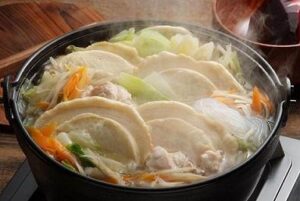
| 青森県で最も有名なB級ご当地グルメは、「八戸せんべい汁」です。肉、魚、野菜、そしてきのこなどを煮込んだ汁の中に、「南部せんべい」を入れる料理で、鍋料理として食べたり、又は、汁ものとして食べたりします。 使用するせんべいは、小麦粉と塩を原料とした「おつゆせんべい」や「かやきせんべい」と呼ばれるもので、専用に開発されたものです。このせんべいはとけにくくて、独特の食感があるように焼いたものです。 「八戸せんべい汁」が食べることができるお店は、八戸市内にたくさんあります。お店毎に個性があるので、自分の好みの味を探してみるのも楽しいと思います。 | The most famous B class Local Dish in Aomori pref. is Hachinohe Rice Cracker Soup. It’s a dish made of meat, fish, vegetables and mushrooms which are cooked together in a broth. After that Nanbu rice crackers are added into it. You can eat it as a one pot dish or as a soup. The rice crackers are made in a special way. They are made from salt and flour. These rice crackers are called “Otsuyu Senbei” and “Kayaki Senbei”. These Senbei are cooked in a special way so they don’t dissolve easily and have a unique texture. There are many restaurants in Hachinohe where you can eat Hachinohe Senbei soup. Each restaurant offers its own unique recipes so it’s fun to go around looking for the dish that you like. |
八戸せんべい汁研究所ホームページ
(URL:http://www.senbei-jiru.com/)
八戸せんべい汁 facebook page
(URL:https://www.facebook.com/senbeijiru)
AOMORI GOURMET website(English)
(URL:http://www.aomori-gourmet.jp/en/hachinohesenbei-jiru.html)
味噌カレー牛乳ラーメン
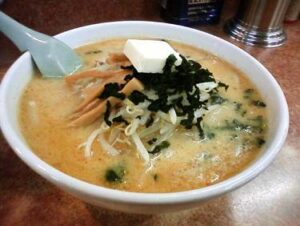
| 「B―1グランプリ」が開催されて、「味噌カレー牛乳ラーメン」がご当地グルメだということを初めて知った方も多いのではないかと思いますが、青森市民にとっては馴染みのグルメです。 味噌スープをベースに、カレー粉と牛乳を入れたラーメンで、バターをトッピングします。 味噌のコク、カレーの刺激、牛乳のまろやかさ、そしてバターの風味が絶妙なバランスを醸し出し、30年以上の間、青森市民に愛され続けるソウルフードです。 青森市内の「札幌館」、「味の札幌大西」、「味の札幌分店」、「札幌ラーメン蔵」「かわら」などで味わえます。 | Besides Aomori residents many people didn’t know that “Miso, Curry and Milk Ramen” is a local Aomori dish till the B-1 grand prix introduced it. This Ramen soup uses Miso as it’s basic ingredients. Curry powder and milk were added into it. Then butter is used as topping. For the lst 30 years this dish is soul food for Aomori people. This Ramen has rich flavor of Miso, spicy curry taste, smooth milk taste and butter flavor. You will fine this Ramen at “Sapporokan”, “Ajino Sapporo ohnishi”, “Ajino Sapporo Bunten”, “Sapporo Ramen Kura” and “Kawara”. These restaurants are Ramen shops in Aomori city. |
青森県観光情報サイト「アプティネット」/グルメ/味噌カレー牛乳ラーメン
(URL:http://www.aptinet.jp/Detail_display_00001904.html)
十和田バラ焼き/ Towada Barayaki
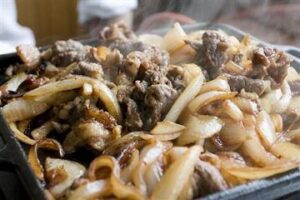
| バラ焼きは三沢米軍基地前の屋台から生まれたと言われています。 米軍の人々は、牛の赤身を好んで食べていたため、他の部位が不要となり、三沢市内ではバラ肉が安く手に入るようになりました。 なるべく少ない量で美味しく沢山食べたいという思いから、韓国から来た方がプルコギをヒントに、手軽に手に入る玉ねぎを大量に使って作り出された料理と言われています。 それが同じ文化圏の十和田市に伝わり、バラ焼きは爆発的に広がりました。 しょう油ベースの甘いタレが、子どもから年配の方にまで幅広く愛され、家族が鉄板を囲んで楽しめるので、十和田市民のソウルフードとして定着しました。 今では60店舗以上のお店でバラ焼きが食べられます。 各お店毎に独自の味があり、シンプルな素材で味わうバラ焼き。 ご飯にのせて、酒の肴に、どんなシーンでも食べられるのが十和田のバラ焼きです。 | Rumor says “Barayaki” came from a small stand near the Misawa Base. Americans prefer to eat red beef meat at that time. The other parts of the beef became available to buy for reasonable price to the residents of Misawa city. With the thought of eating Using the small amount of beef and lots of onions, that’s the way people can eat a lot. This idea came from the Korean dish call “Bulgog”. Barayaki spread quickly into Towada city which has the same culture. This is the soul dish for the people of Towada. Everyone likes its sweet soy souce flavor. It’s a popular family get together meal. There are now over 60 shops where you can eat Barayaki. Each shop has its own recipes and you will enjoy it. You can eat with rice, as a side dish or any way you like. This is Towada Barayaki. |
十和田バラ焼きゼミナール / Towada Barayaki Seminal
(URL:http://www.barayaki.com/)
AOMORI GOURMET website(English)
(URL:http://www.aomori-gourmet.jp/en/towadabarayaki.html)
黒石つゆやきそば/ Kuroishi Tsuyu-Yakisoba
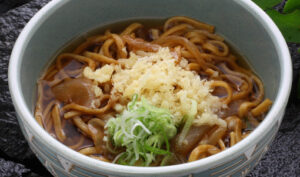
| 1960年頃に、焼きそばにつゆを掛けた「つゆそば」が黒石市で生まれました。その頃を懐かしみつつ、今も黒石市内のいろいろなお店で作られています。 『黒石つゆやきそば』の麺は、太くて平らで食感があり、黒石市内の工場で作られています。 この麺を使ってソース焼きそばを作り、和風のダシをかけ、“揚げ玉”(天ぷらを揚げるとき油の中に散った衣のかす)とねぎをのせます。 お店によっては、中華風のダシを使ったり、天ぷらやカツをのせたり、いろいろなつゆやきそばを楽しむことができます。 「焼きそばにつゆを掛けるの?!」と思われるかもしれません。「不思議な食べ物?」、「新しいラーメン?」という意見がありますが、『黒石つゆやきそば』は、全国的にもB級ご当地グルメとして有名になっています。 | Tsuyu-Yakisoba was first made in Kuroishi in 1960 when soup was served with ‘yakisoba’ (fried noodles). The dish is still eaten in Kuroishi today, evoking a feeling of the “good old days”. The noodles used in Tsuyu-Yakisoba are made at a factory in Kuroishi, and are flat with an unmistakably thick texture. Using these noodles, the cook makes yakisoba in the traditional way, but then adds Japanese soup stock and tops the dish with spring onion and ‘agedama’ (crumbs of deep-fried batter). In fact, there are many ways to make Tsuyu-Yakisoba using different combinations of ingredients, for example, using a special Chinese soup stock, or tempura or pork cutlet as toppings. Those familiar with Japanese food may find it quite strange to add soup to yakisoba “Is this some new kind of ramen?” Maybe it is. Kuroishi Tsuyu-Yakisoba is gradually taking root as a popular ‘B class dish’ in Japan. |
青森県観光情報サイト「アプティネット」/グルメ/黒石つゆやきそば
(URL:http://www.aptinet.jp/Detail_display_00003628.html)
AOMORI GOURMET website(English)
(URL:http://www.aomori-gourmet.jp/en/kuroishiyakisoba.html)
大湊海軍コロッケ/ Ōminato Navy Croquettes
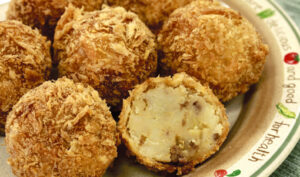
| 『大湊海軍コロッケ』のレシピは、むつ市大湊に配備されていた旧海軍で食べられていたもので、2008年から販売されるようになりました。 『大湊海軍コロッケ』は、「ヘット」と呼ばれる牛の脂で揚げます。豚の脂の「ラード」に比べて、カラっとした食感に出来上がります。 下北半島の東通村の牛肉や、むつ市大畑の豚肉などを使っています。それぞれのお店で、色々なアレンジをして出していますので、食べ比べてみるのも楽しいかもしれません。 | Ōminato Navy Croquettes were a food of the past, something served long ago to naval forces deployed in Mutsu, Ōminato, but the food made a comeback in 2008. Rather than pork fat, Ōminato Navy Croquettes are deep-fried using beef fat (called ‘hetto’) which gives each croquette an especially crispy texture. The filling is generally made using beef from Higashidōri or pork from Ōhata, both areas of the Shimokita Peninsula. However, each shop has its own style and it’s fun to compare the different tastes! |
青森県観光情報サイト「アプティネット」/グルメ/大湊海軍コロッケ
(URL:http://www.aptinet.jp/Detail_display_00003872.html)
青森生姜味噌おでん
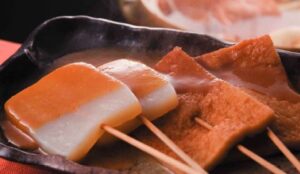
| 「おでん」と言えば、日本では昔からよく食べられていて、その歴史は室町時代(1336~1573年)の焼き豆腐に味噌をつけた「田楽」という料理に始まります。 そして、江戸時代(1603~1868年)には今のような形で、煮込んで食べるようになりました。 永い歴史の中でそれぞれの地方でそれぞれの食べ方が発達しましたが、生姜を加えた味噌で食べる『青森生姜味噌おでん』もその一つといえるでしょう。 これは、第二次世界大戦後、青森駅前の近くにできた屋台で出されていた「おでん」が始まりだったようです。冬の厳しい寒さの中、「青函連絡船」に乗り込もうとする船客を少しでも暖めようと、ある一軒の屋台のおかみさんが味噌に生姜を入れたものを、おでんにつけて出したのが喜ばれ、広まっていったようです。 ※「青函連絡船」=1908年から1988年までの間、青森県の青森駅と北海道の函館駅との間を結んでいた鉄道連絡船。青函トンネルが出来てから無くなりました。 | ‘Oden’ (various foods boiled in a soy-flavoured broth) has been popular among the Japanese people for a long time and can be traced back to a food from the Muromachi Era (1336-1573) called ‘Dengaku’ – baked tofu with miso. People began to cook Oden in its current form in the Edo Era (1603-1868), and there are now many varieties, but in Aomori we eat it with ginger and miso. The story goes that Ginger Miso Oden was first served from a small stand in front of Aomori Station during the time after WW II. During the extremely cold winter months, the stand’s female owner would sell this warm food to those waiting to board the ‘Seikan Renrakusen’. ※ The Seikan Renrakusen was a famous boat which operated between Aomori Station and Hokkaido’s Hakodate Station from 1908 to 1988. The boat’s service ended when a direct tunnel between Aomori and Hakodate was opened. |
青森県観光情報サイト「アプティネット」/グルメ/青森生姜味噌おでん
(URL:http://www.aptinet.jp/Detail_display_00001905.html)
